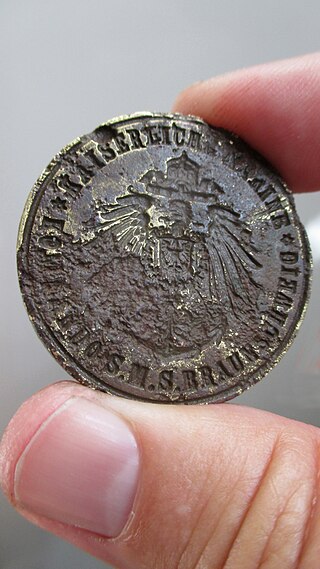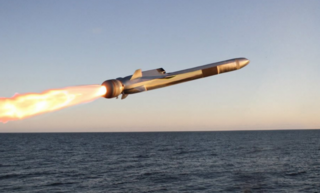
The German Navy is the navy of Germany and part of the unified Bundeswehr, the German Armed Forces. The German Navy was originally known as the Bundesmarine from 1956 to 1995, when Deutsche Marine became the official name with respect to the 1990 incorporation of the East German Volksmarine. It is deeply integrated into the NATO alliance. Its primary mission is protection of Germany's territorial waters and maritime infrastructure as well as sea lines of communication. Apart from this, the German Navy participates in peacekeeping operations, and renders humanitarian assistance and disaster relief. It also participates in anti-piracy operations.

The Kriegsmarine was the navy of Germany from 1935 to 1945. It superseded the Imperial German Navy of the German Empire (1871–1918) and the inter-war Reichsmarine (1919–1935) of the Weimar Republic. The Kriegsmarine was one of three official branches, along with the Heer and the Luftwaffe, of the Wehrmacht, the German armed forces from 1935 to 1945.

The Royal Norwegian Navy is the branch of the Norwegian Armed Forces responsible for naval operations of Norway. As of 2008, the Royal Norwegian Navy consists of approximately 3,700 personnel and 70 vessels, including 4 heavy frigates, 6 submarines, 14 patrol boats, 4 minesweepers, 4 minehunters, 1 mine detection vessel, 4 support vessels and 2 training vessels. It also includes the Coast Guard.

HisMajesty's Ship, abbreviated HMS and H.M.S., is the ship prefix used for ships of the navy in some monarchies. Derived terms such as HMAS and equivalents in other languages such as SMS are used.

The Penguin anti-ship missile, designated AGM-119 by the U.S. military, is a Norwegian passive IR seeker-based short-to-medium range anti-ship guided missile, designed for naval use.

The Álvaro de Bazán class, also known as the F100 class, is a class of Aegis combat system-equipped air defence frigates in service with the Spanish Navy. The vessels were built by Spanish shipbuilder Navantia in Ferrol, with the lead ship of the class named for Admiral Álvaro de Bazán.

Skjold-class corvettes are a class of six light, superfast, stealth missile corvettes in service with the Royal Norwegian Navy. The boats were formerly classed as MTBs but, from 2009, the Royal Norwegian Navy has described them as corvettes (korvett) because their seaworthiness is seen as comparable to corvettes, and because they do not carry torpedoes. They were built at the Umoe Mandal yard. With a maximum speed of 60 knots (110 km/h), the Skjold-class corvettes were the fastest combat ships afloat at the time of their introduction.

The Hunt class was a class of escort destroyer of the Royal Navy. The first vessels were ordered early in 1939, and the class saw extensive service in the Second World War, particularly on the British east coast and Mediterranean convoys. They were named after British fox hunts. The modern Hunt-class GRP hulled mine countermeasure vessels maintain the Hunt names lineage in the Royal Navy.

A training ship is a ship used to train students as sailors. The term is mostly used to describe ships employed by navies to train future officers. Essentially there are two types: those used for training at sea and old hulks used to house classrooms.

Statsraad Lehmkuhl is a three-masted barque rigged sail training vessel owned and operated by the Statsraad Lehmkuhl Foundation. It is based in Bergen, Norway and contracted out for various purposes, including serving as a school ship for the Royal Norwegian Navy.

The Naval Strike Missile (NSM) is an anti-ship and land-attack missile developed by the Norwegian company Kongsberg Defence & Aerospace (KDA).

The history of the Danish navy began with the founding of a joint Dano-Norwegian navy on 10 August 1510, when King John appointed his vassal Henrik Krummedige to become "chief captain and head of all our captains, men and servants whom we now have appointed and ordered to be at sea".

The Royal Norwegian Navy Museum is a museum documenting the history of the Royal Norwegian Navy. It is located at the former main naval base of Karljohansvern in Horten. The museum was founded by C.F. Klinck on 24 August 1853. The museum is sometimes regarded as the world's first naval museum, as it was the first collection of naval memorabilia open to the public.

HNoMS Tordenskjold, known locally as Panserskipet Tordenskjold, was a Norwegian coastal defence ship. She, her sister ship, Harald Haarfagre, and the slightly newer Eidsvold class were built as a part of the general rearmament in the time leading up to the events in 1905. Tordenskjold remained an important vessel in the Royal Norwegian Navy until she was considered unfit for war in the mid-1930s.
HNoMS Tyr was a Gor-class Rendel gunboat built for the Royal Norwegian Navy at Karljohansverns Verft Naval Yard in Horten. She was laid down in 1884 and launched in 1887 with build number 67. Tyr was one of a class of two gunboats - the other ship in her class being HNoMS Gor. Gor and Tyr can be seen as improved Vale-class gunboats, of 290 tons instead of the 250 tons standard for that class.

Minentaucher is the German term for mine clearance divers. The Minentaucherkompanie is a specialist unit within the German Navy responsible for underwater tasks including removing or salvaging underwater munitions such as mines and for servicing underwater drones. It is part of the Sea Battalion and is based in Eckernförde.

Naval trawlers are vessels built along the lines of a fishing trawler but fitted out for naval purposes; they were widely used during the First and Second World Wars. Some—known in the Royal Navy as "Admiralty trawlers"— were purpose-built to naval specifications, others adapted from civilian use. Fishing trawlers were particularly suited for many naval requirements because they were robust vessels designed to work heavy trawls in all types of weather, and had large clear working decks. A minesweeper could be created by replacing the trawl with a mine sweep. Adding depth charge racks on the deck, ASDIC sonar below, and a 3-inch (76 mm) or 4-inch (102 mm) gun in the bow equipped the trawler for anti-submarine duties.

The Tall Ships Races are races for sail training "tall ships". The races are designed to encourage international friendship and training for young people in the art of sailing. The races are held annually in European waters and consists of two racing legs of several hundred nautical miles, and a "cruise in company" between the legs. Over one half of the crew of each ship participating in the races must consist of young people.

HSwMS Najaden is a Swedish Navy training ship launched in 1897, previously preserved as a museum ship in Halmstad and moored on the river Nissan by Halmstad Castle, since July 2014 in Fredrikstad, Norway.

HMS Buttercup was a Flower-class corvette built for the Royal Navy. She served during the Second World War first as part of the Royal Navy Section Belge (RNSB), and then later as part of the Royal Norwegian Navy. Between 1946 and 1957 she served as HNoMS Nordyn. The Norwegian government then sold her and she became the whaler Thoris until she was broken up in 1969.


















